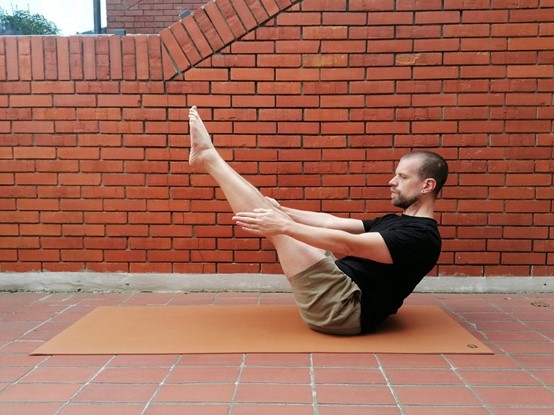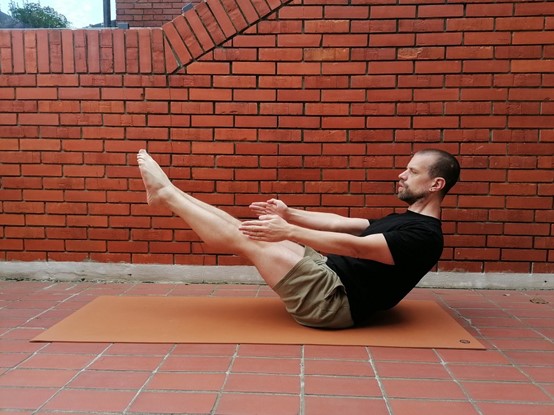The word “nava”, translated from Sanskrit, means “boat. This article will explain and demostratge the yoga pose Navasana.
A Deeper Insight
This pose can easily be classified as a lower balance pose. It can also be classified as a strong pose. Having in mind that this pose essentially involves the engagement of almost the entire body, it cannot be characterized as one of the basic yoga poses, regardless of the variations that exist.
When we talk about balance within this pose, there are several ways to achieve it. The first way is both the most correct and the most difficult. This method implies that the exerciser achieves balance by leaning on his coccyx. This pose can be a challenge for a number of practitioners, especially if they have a dislocated coccyx. In that case, it is not only the achievement of balance called into question but also the possible pain that can be caused by the position of the coccyx itself. If the practitioner wishes, he can place a pillow or blanket under the yoga mat if this will lead to a reduction in possible pain.
The second way implies that the exerciser does not rely on the coccyx but on the saddle halves. This pose does not require a highly developed sense of balance. However, the moment of visualization can be a problem here. Essentially, in order for the practitioner to enter the pose itself, he must be fully aware of both the right and left saddle halves. And to try to “stretch” them to the side as much as possible. In this way, he will be able to focus the load on the saddle halves and not so much on his coccyx.

The body is adjusted in the upper part of this pose after entering and adjusting to the lower pose. The full pose means that your legs are stretched forward, and your toes are at eye level. It is also implied that your arms are stretched forward. Your hands are at shoulder height. Your back and neck are fully stretched. While you are in this pose, your stomach is active the whole time. The back muscles are also active, especially the lower ones. In the full pose, there is a complete opening of the chest and a fine inward rotation of the hips.
The gaze should be directed at the tips of the toes. I advise you to always use mula and uddiyana bandha. By using them, you will stay in the pose longer. Breathing during the pose can be exclusively through your nose. So, try to make your exhalation twice as long as you inhale.
If you use the breathing, bandhas, and gaze in the correct way, you will have no problem staying in the same pose longer than the practitioners who are not aware that by using these three things, they can greatly influence the improvement of their yoga practice.
Variations and Preparation
In addition to the full pose, there are also variations. In the case of this pose, not all variations are easier solutions. The first variation implies that the legs are not stretched but bent at the knees so that the calves are in line with the yoga mat. In this way, there is less involvement of the abdominal muscles, especially the lower ones, so the exerciser can stay longer in this variation compared to the full pose.

The second variation implies that the legs are stretched as in the full pose, but in this variation, the fingers are interlaced, and the palms are placed on the back of the head. This variation involves spreading the elbows out to the side as much as possible. The full pose of the elbows means that they are in line with each other. This variation is the most challenging position of all.
The third variation is the so-called lower boat. The body goes all the way down with the legs stretched forward. The heels are slightly raised from the floor. The chin is slightly bent towards the sternum, the shoulder girdle and the middle part of the back are lifted from the yoga mat, and the arms are stretched forward towards the toes.
In the full pose, you can also use the belt in case stretched legs are a challenge. In that case, the belt would go around the ankles; it would be stretched towards the body, and you would hold it with your hands. In this way, they would also achieve additional support, which is certainly good for exercisers who face balance problems.
If you want to prepare your body before practicing this pose, feel free to do the following short yoga sequence in the way I will describe.
You start the sequence from the Dandasana pose. Stay in it for at least ten breaths and breaths. After the last exhalation, slowly move into the fallen warrior’s preparatory pose, bending the legs at the knees and placing the palms in front of the knees. While you are sitting on your heels, point your toes and transfer your weight completely to your palms. Use your palms to glide forward, determine your proportion, and gently come into a downward-facing dog. Also, stay in it for at least ten breaths and then ten more. From there, slowly enter Uttanasana. After the tenth exhalation, enter Utkatasana.
In this pose, there is a minimum of 10 inhalations and exhalations.
This is a mini-sequence that you can practice each time before practicing the boat pose. Of course, if you practice the pose as part of Ashtanga or Vinyasa yoga, it is impossible to do this mini-sequence.
Benefits
The boat pose is great for strengthening the entire core.
Therefore, it is good for strengthening the muscles of the entire abdomen and back muscles. First of all, lower back muscles. Its influence on strengthening the legs and glutes should certainly not be overlooked.
On the other hand, this pose has a positive effect on the digestion process itself and leads to an increase in the focus of the exerciser.
Conclusion
This pose could be said to be one of the few poses that can be characterized as a complete position in every sense.
It involves a developed sense of balance, it involves the engagement of the whole body, it involves a strong body if we want to do it completely correctly, and it involves openness of the body, especially of the hips.
If the hips of the practitioner are not open enough, if there is no good inward rotation, the pose itself will not be done completely correctly. It is very important that you become aware of which part of your body is currently experiencing the biggest challenge while performing this pose.
Work to improve it. In this way, you will slowly but surely move toward the full pose.







